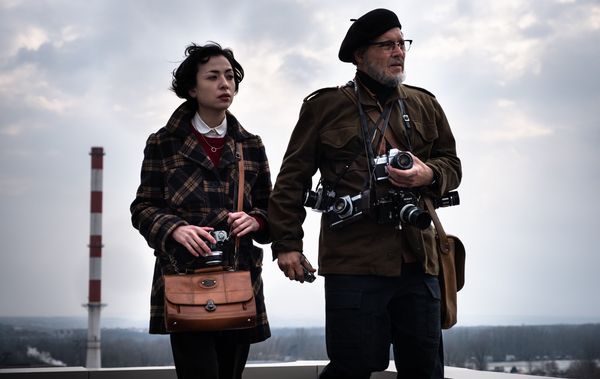 |
| Minami and Johnny Depp in Minamata |
A celebrated artist known across Europe for his Metalwork Installations®, Andrew Levitas has worked in photography, sculpture and painting, creating his own pigments and exhibiting in numerous prestigious venues, but in recent years he has also taken an interest in film. His second feature, Minamata, takes a coruscating look at the man-made tragedy which struck a small Japanese community in the mid-Fifties, and shows how Life magazine’s war photographer, W Eugene Smith, brought it to international attention. Smith is played by Johnny Depp as you’ve never seen him before, in one of his career best performances, but the soul of the film belongs to its Japanese characters, with equally impressive work from Hiroyuki Sanada.
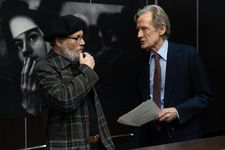 |
| "He's an avatar for us, right?" |
When we meet, Andrew’s passion for the subject is immediately obvious. To him it’s not just a historical story but one which is acutely relevant today. I ask him about Smith’s famous photographs and he tells me that they one of the inspirations for his whole career.
“I remember seeing, in particular, the Minamata work. My parents had a bunch of Life magazines, and by 10 or 12 years old I had gone through them, you know, just sitting around. They were from years earlier. I was born after this. And I remember looking at this particular image, the image of Tomoko in the bath, and feeling these complicated feelings that I never felt before when looking at at an image, or really at all. I was seeing things that were just devastating to look at, but for whatever reason, I didn't feel devastated, and I never forgot that feeling, like something about it made me feel uplifted. I couldn't get my head around it.
“Years later, as I became an artist, and studied photography, and studied Smith, and learned more about the world, I re-examined that work and I realised what it was was. Yes, you were looking at the darkest possible aspect of humanity, but it was juxtaposed, right in front of you, with the very best of humanity: with the love and the compassion and the kindness and the hope. And that, in a single image, seems to have more strength and power than the darkness. And that always stuck with me. So I've always sort of hoped to find that kind of approach in all of my work, in any medium, that idea of looking at these harder moments but focusing on the heroic nature of the people dealing with them, and seeing how they can inspire us as individuals and inspire us to be better and to find ourselves and to stand up for each other and all that, and find our voices.
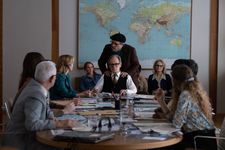 |
| "Make it so that other people become aware" |
“It took a while before I was able to make this film. It was 20 years later than that. But part of why I wanted to make it was it felt like it was just as relevant today as it was then, both because there are still victims and patients and that amount of fighting to be heard, fighting to just be acknowledged and seen. And then, of course, we have similar issues. Pretty much every city, every state, every country are dealing with their own version of industrial pollution, corporate greed, and a marginalising of most of us in the pursuit of dollars by a very few of us. And so it felt really important to do it at that moment. Also, because I felt that we in the US and around the world, when this process started a few years ago, pre-pandemic, we seemed to be having less power.
“It seems to be getting harder to put food on the table and take care of our families and take care of ourselves, and there seems to be this bigger wealth disparity, there seems to be more difficulty somehow in the world. You read these articles about all these things that are progressing and how the world is getting better. And everyone seems to be living a worse life in a way, and a harder life and a more depressed life. And people, their voices weren't being heard. And so it felt like it was time. And then of course, we had a global pandemic and it feels even more prevalent today.”
Bringing the production together meant working across several countries. Did he find the same attitude everywhere? Were people in Japan still uncomfortable about dealing with this particular situation?
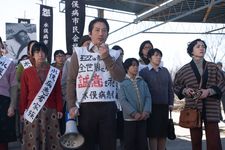 |
| "The fact that this group just had enough, and not only, you know, spoke up, but fought and fought publicly...was especially heroic." |
“You know, what's interesting is that in Japan, there wasn't as much awareness, all these years later, about what was going on on the ground in Minamata currently and what had happened all those years ago. I hear from crew and different friends I've made along the way that it’s something that they talk a little bit about in school and they kind of remember but just wasn't present for them. I found it remarkable that, you know, they didn’t turn over a new leaf and go ‘Okay, these are issues, this is real stuff. We're living in 2021 - now ‘22 – you know, we didn't tackle these things head on, right the wrongs of the past and make sure that we don't have another Minamata.’
“Of course, they had a version of a Minamata – different, but, you know, they had a nuclear meltdown. These are big issues. And also, what was interesting is that there was such a disconnect around the world with everybody's local issues, and it felt like politically and otherwise, we've all been forced to think of every issue as its own smaller issue, that's just our problem in this city or our problem in this town, or our neighbour’s. Versus, it's really the same issue, right? It's the same global issue, we're not looking after each other, we're not looking after the environment, we're not looking after, you know, the 99.9999% of people that aren't making millions of dollars every year by investing in energy companies, or plastics companies, or whatever. And I found that quite remarkable.
“It was one of the things that at the time when the images came out in Life Magazine, you know, there were less places to get your information. And so that magazine travel globally, and those images travelled globally and connected everybody. Everyone realised, I think, that this was happening everywhere, the same. But we seem to have lost that. That, I thought, was quite interesting, and also a reason to build out the end credit secrets in the way that we did. As a reminder of that, specifically.”
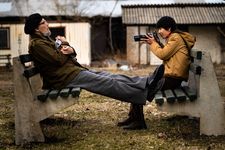 |
| "Every one of them came up with some version of not just ‘Yes, you have our approval to make this film.’ but ‘You must make this film.'" |
The sequence he’s referring to shows images from other pollution scandals around the world, each with its own horrific impact on local populations. I suggest that in Japan there might be an additional layer of difficulty in talking about this issue because of the old belief that disability occurs only to people who have done bad things in their previous lives, which means there’s a lot of stigma and shame. How did he approach filming in order to ensure that the people affected by the disaster could retain their dignity?
“Part of why I found this community especially heroic or worthy, or inspirational was that in spite of the issues that one would have had dealing with something like this anywhere, in particular, in Japan at that time, and now, but really at that time, societal norms were such that, yes, if you were shamed, you would stay in the shadows,” he says. “And that's actually why a lot of these things were allowed to continue, because people were just put in a corner and they didn't want to come out, they didn't want to be seen. Early in the film, you have a man carrying his dead child down the train tracks, and that's because at the time, they weren't allowed on the train, because people thought that it was contagious in some way, even though they knew better. And so the fact that this group just had enough, and not only, you know, spoke up, but fought and fought publicly, and brought someone in that could help shine that light to document that, was especially heroic.
“From my perspective, beyond that, I wouldn't have made this film without not just support, but at the urging of the current patients, victims, and families of those who have lost children or relatives. And so I went to Japan and met with Aileen Smith [W Eugene Smith’s half-Japanese, half-American widow] and I went and met with quite a few families and victims, and almost every single one of them, after deep conversations and learning about me and kind of sussing me out, sharing a lot of, you know, sort of quieter thoughts – every one of them came up with some version of not just ‘Yes, you have our approval to make this film.’ but ‘You must make this film. But don't make it for us. Make it so that there aren't any more Minamatas. Make it so that other people become aware, and hopefully we can help others.’
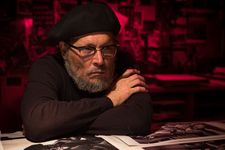 |
| "I think it's actually the most authentic character that Johnny's ever played, and the most similar to who he is in real life." |
“That was so so generous and giving for them, to put us on that journey, that it really forced me to never question or look back, you know, in the harder moments of making the film or in the build up to making the film. I had to do it. I was given that mandate.”
The film was given a big boost in terms of audience reach when Johnny Depp came on board. It’s obvious that he’s passionate about the subject too, and I ask Andrew what it was like to work with him, especially in what seems like a pivotal role where he has completely abandoned his pretty boy image.
“What was really remarkable about Johnny, as it pertains to this film is that his character is not the star of this stuff,” he says. “The film is this community in Japan, the heroes that are there, and his character is really there to document that. And he's an avatar for us, right? He's there for the audience, to see it through this really unique and special and beautiful lens and Eugene Smith, which allows us to be more poetic and elegant in the storytelling. And so there wasn't a lot of consideration about how Johnny was supposed to look, other than we had an enormous amount of photographs of Gene Smith, so we tried to match that as best we could. Our work was really based on the internal life of Gene, and who he was walking into this.
“Johnny and I worked quite hard on trying to understand Gene, on trying to get into Gene’s skin, really, so that once he walked onto my stage on my set, he could just live in Gene. And that's what he did. He came on and he was Eugene Smith, he lived these experiences authentically. And what's interesting is that he's almost unrecognisable, but he actually has less makeup and less stuff on than in probably any other film he's ever done. He's less recognisable because he's so different as a character. But also, interestingly, I think it's actually the most authentic character that Johnny's ever played, and the most similar to who he is in real life. And his audience aren’t used to seeing that so there's a weird discord. I've had many people watch film that just stayed until the end. They were like, ‘I totally forgot that that was Johnny Depp, that guy was amazing.’ And that was, you know, quite satisfying.”
Minamata is out now in US cinemas, while UK residents can watch it on numerous streaming services.





















